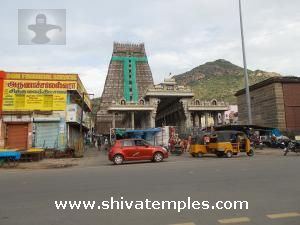Daarsanath Abra sadasi, Jananath Kamalalaye, Kasyanthu maranath mukthi , Smaranath arunachale ||
"By seeing Chidambaram, by being born in Tiruvarur, by dying in Kasi, or by merely thinking of Arunachala, one will surely attain Liberation". Tiruvannamalai is highly revered for its role in achieving salvation, which can be attained simply by contemplating it. While not everyone may have the opportunity to physically visit Chidambaram, be born in Thiruvarur, or pass away in Kashi, focusing one's thoughts on Tiruvannamalai is easy. The central point of interest in the town is the sacred hill, which is believed to have transformed from a hill of fire in the 'Krita' Yuga, to a hill of ruby in the 'Thretha' Yuga, to a hill of gold in the 'Dwapara' Yuga, and finally to a rock hill in the 'Kali' Yuga. This location is closely linked to Saint Arunagirinathar, who composed Tirupugazh. Additionally, Tiruvannamalai is the site of the Ashram established by the revered Saint Philosopher Ramana Maharishi.
Temple Legend - An argument once arose between Brahma and Mahavishnu regarding their supremacy, leading to a divine intervention by Shiva. Shiva materialized before them as a singular beam of flame, leaving both deities in awe. In an attempt to comprehend the extent of the flame, Mahavishnu transformed into 'Varaha', a wild boar, to reach the base, while Brahma took the form of a swan and flew upwards to see its peak. However, neither of them could perceive the beginning or the end of the flame, leading to the realization that Shiva was the ultimate supreme being. As a result, both deities worshipped Shiva, who then manifested as 'Arunachalam' before them. The name 'Arunachalam' is derived from the words 'Arunam', meaning the color red or fire, and 'Asalam', which denotes a hill. It was at this sacred site that Shiva took the form of Lingothbhava. To commemorate the first appearance of Lingothbhava, a huge sacred fire is lit atop the Annamali Hill during Karthigai Deepam in November/December. The light emitted from this fire is so powerful that it can be seen from a distance of up to 40 kilometers.
Temple Layout - Tiruvannamalai Arunachaleswarar Temple is one of the largest temples in Tamil Nadu. It is one of the five grand temples associated with the five basic elements of nature - the 'Pancha Bhoota Sthalangal'. Tirvannamalai is associated with the element Fire, the other four being Tiruvanaikkaval (Water), Chidambaram (Space), Kanchipuram (Earth) and Sri Kalahasti (Wind). The temple comprises six prakarams, nine gopurams, numerous mandapams and multiple sannidhis making it a primary destination for all pilgrims. The 'Swayambhoo Linga' of Arunachaleswarar is adorned with a 'nagam' and is dressed in pristine white garments. Lingodhbavar is positioned behind Arunachaleswar, as this temple marks the first instance of this manifestation. The female deity Unnamalai Ammai is in a separate sannidhi positioned to the left of the sannidhi of the presiding deity.
4 magnificent gopurams are on each sides and all of them provide access to the temple. 4 more gopurams are located within the temple and another one called 'Kili gopuram' in the east facilitates entrance from 4'th prakaram to 3'rd prakaram. The rajagopuram in the east is the second largest in Tamil Nadu, standing at a height of 217 feet with 11 levels. The one in the south is known as 'Tirumanjana' Gopuram, 'Pei' Gopuram is in the west and 'Ammani Ammal' Gopuram is in the north.
Arunachalam, a prominent hill standing at an elevation of 2668 feet, is also known by various other names such as Mukthipuri, Arunagiri, and Sonagiri. Pilgrims partake in the spiritual practice of giri valam, which involves circumambulating the Annamalaiyar temple and Annamalai hill, covering a distance of 14 km in circumference, throughout the year. This practice is revered as a simple yet effective form of yoga. The hill is believed to be inhabited by numerous 'Siddhars', and therefore, performing 'giri valam', especially on a full moon day, is considered highly auspicious. It is said that during full moon days, a multitude of siddhas visit the hill, and the gentle breeze carries the positive effects of the herbal shrubs and trees growing on the hill, bringing tranquility to the mind and bestowing health benefits upon those who partake in the ritual. Presently, hundreds of thousands of devotees continue the tradition of walking around the hill on full moon days to pay homage to Annamalai and receive the blessings associated with the practice. Within the 14 km circumference of the hill, there are eight small shrines of lingams, each linked to the 12 moon signs. These lingams, including Indra Lingam, Agni Lingam, Yama Lingam, Niruthi Lingam, Vayu Lingam, Kubera Lingam, and Esanya Lingam, collectively known as Ashta Lingam, are an integral part of the worship rituals during 'girivalam'. The Aadhi Annamalai temple, as mentioned in Thevaram, is situated along the path on the right side of the hill, adding to the spiritual significance and historical importance of Arunachalam.
There are six energy centers, known as chakras, within the human body. The 'Manipura' chakra, located in the stomach area, is associated with Tiruvannamalai. All living beings in the world strive to fulfill their hunger, and it is believed that the movement of the entire world is encompassed within the stomach of Annamalayar.
To know more visit the official website of this temple

 Shivagangai theertham, gopuram and annamalai hill
Shivagangai theertham, gopuram and annamalai hill View of the temple and the hill
View of the temple and the hill View of the temple
View of the temple Entrance
Entrance Murugar sannidhi
Murugar sannidhi Inside view
Inside view Inside view
Inside view Kalatheeswarar sannidhi
Kalatheeswarar sannidhi